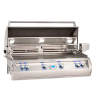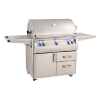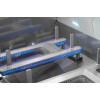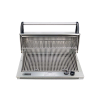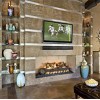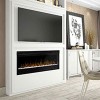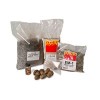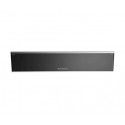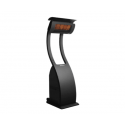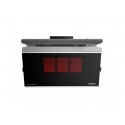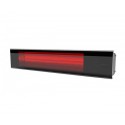FAQs
Fire Magic
Dimplex
Dimplex is the leader in the electric heating industry, known for its innovative technology, energy efficiency, and stunning design. Here's why investing in Dimplex products offers great value:
- Innovative Technology: Dimplex continuously pushes the boundaries of innovation with features like the ultra-realistic flame effects in their electric fireplaces.
- Energy Efficiency: If you're looking to reduce your environmental impact and save on energy bills, Dimplex products are an excellent choice. They are designed to provide maximum warmth with minimal energy use.
- Wide Range of Options: Dimplex offers a diverse array of products to fit every need and interior style. Whether you need built-in fireplaces, inserts, or outdoor solutions, you can find the perfect match.
- Design and Aesthetics: With a focus on aesthetics, Dimplex products are designed to enhance the visual appeal of your space, blending seamlessly with your décor.
- Customer Support and Warranty: Dimplex values customer satisfaction highly, offering robust support and comprehensive warranties for peace of mind.
Investing in Dimplex means investing in a heating (or just flame) solution that delivers performance, efficiency, style, and value. We invite you to explore our collection and experience the benefits of Dimplex firsthand.
Dimplex electric fireplaces are not only a source of warmth but also provide a visually appealing ambiance at a minimal cost. Dimplex flame features consume a modest amount of power, less than 300 Watts, leading to an operating cost of approximately 3 cents per hour. This makes it a budget-friendly option for those who want to enjoy the aesthetic of a fireplace without a hefty expense.
When heating is activated alongside the flame, the power usage increases to about 1500 Watts. Despite this higher energy requirement, the overall operational cost remains economical at about 8 cents per hour, provided the heater operates at a 50% cycle. This is significantly more cost-effective compared to traditional gas fireplaces, which typically cost around 17 cents per hour to run.
The considerable savings offered by Dimplex fireplaces make them an attractive choice for anybody looking to add an electric fireplace to their home.
If your fireplace comes equipped with media such as glass, stones, or river rocks, you may substitute it with alternatives of your choice. However, it's crucial to ensure that the replacement media does not exceed the weight of the original media. Additionally, avoid using any fine substances like sand or any liquids to prevent internal damage.
Dimplex electric fireplaces are renowned for their quality, durability, and advanced technology. On average, a Dimplex electric fireplace can last a decade or more, depending on the frequency of use and how well it is maintained.
Key Factors Influencing Longevity:
- Usage Frequency: The lifespan of your Dimplex fireplace largely depends on how often you use it. Regular daily use may slightly reduce the overall lifespan, while occasional use can help extend it. However, thanks to Dimplex's advanced engineering, even with frequent use, these fireplaces are built to endure.
- Maintenance: Proper maintenance is crucial in ensuring your fireplace lasts as long as possible. Regularly cleaning the unit, ensuring proper ventilation, and checking for any wear and tear can help prevent issues that might shorten its lifespan.
- Technology and Components: Dimplex fireplaces feature cutting-edge technology, such as LED lighting, which is known for its longevity. Unlike traditional bulbs, LED lights used in Dimplex fireplaces can last up to 50,000 hours, significantly extending the fireplace's life. Additionally, the quality of internal components, like the heating elements and fans, is designed for durability.
- Warranties: Dimplex offers warranties that vary by model, typically ranging from one year up to five years. While the warranty period provides an indication of the manufacturer’s confidence in the product's durability, many customers find their Dimplex fireplaces continue to function well beyond the warranty period with proper care.
It is generally cheaper to run an electric fireplace than a gas fireplace. On average, running an electric fireplace costs about $10.80 per month when used at maximum settings, compared to approximately $28.80 per month for a gas fireplace. This difference is due to the lower cost of electricity compared to natural gas and the energy efficiency of electric fireplaces.
Electric fireplaces also offer the added benefit of allowing you to control the heat output more precisely, potentially reducing energy usage even further. Overall, for those looking to save on heating costs, an electric fireplace is a more economical choice.
Cleaning your Dimplex electric fireplace is crucial for maintaining its performance. Here’s how to clean the inside, with tips specific to the Optimyst® system and other Dimplex models:
Cleaning Tips for Dimplex Optimyst® Fireplaces: (Watch Maintenance Video)
- Turn Off the Power: Always switch off the main power before starting any maintenance.
- Check Flame Lighting: Ensure the flame lighting is working fully before cleaning.
- Clean the Interior:
- Dirt, dust, or limescale can accumulate inside, especially in the water tank, nozzle, or water reservoir (sump).
- Remove loose plastic parts like the water tank and nozzle. Clean them with warm water, mild detergent, and a soft brush.
- Check the air vents at the bottom of the fireplace and remove any dust with a soft brush and a vacuum cleaner.
- Inspect for Damage: Look for any signs of damage during cleaning. Contact a Dimplex dealer if repairs or replacements are needed.
- Final Touches: After cleaning the interior, check and clean the decoration and polish the fireplace glass on both sides for a streak-free finish.
- Turn Off the Power: As with any maintenance, ensure the fireplace is turned off completely.
- Minimal Maintenance Needed: These models are almost maintenance-free, except for cleaning the glass and decorations.
- Clean the Glass:
- Remove the glass carefully, following the instructions in the manual.
- Clean both sides with a mild detergent and a cloth for a clear, streak-free appearance.
- Dust the Decoration and Heater Outlet: Gently dust off any decorative elements inside the fireplace and clean the heater outlet vents if present.
Real Fyre
What control valve do you have?
- Locate the valve knob on the right, and ensure the knob is in the "OFF" position.
- Turn the knob counter-clockwise to "PILOT".
- Once it is on "PILOT", push the knob fully in firmly.
- While holding it in, use a long fireplace match or a lighter and light the thermocouple.
- Keep the knob held down for 30-60 seconds after the pilot is lit, and then release the knob.
- Locate the valve knob on the right, and ensure the knob is turned to the "OFF" position.
- Turn the knob to "PILOT".
- Once it is on "PILOT", push the knob fully in firmly.
- While holding it in, use a long fireplace match or a lighter at the pilot burner.
- Keep the knob held down for approximately 60 seconds after the pilot is lit, and then release the knob.
- Locate the ignitor control knob (the bottom knob), and ensure the knob is turned to the "OFF" position.
- Push in and turn the ignitor control knob quickly past the ignite position until you hear a click.
- If you don't hear a "click" noise, turn the ignitor control knob back to "OFF" and repeat step 2.
- If you do hear a "click" noise, keep the control knob held in for 30-60 seconds after the pilot is lit, and then release the knob.
- Locate the valve on the side of the unit, and ensure the control knob is turned to "OFF".
- Turn the control knob counterclockwise to "PILOT".
- Push the control knob firmly and fully in and hold.
- Hold a long lit fireplace match or a lighter near the thermocouple to light the pilot.
- Continue to hold the control knob in for approximately 60 seconds after the pilot is lit, and then release the knob.
Remote is not working for pilot - Troubleshooting
Ensure that the batteries in the receiver inside the fireplace are fresh. Over time, batteries can lose their charge, which can prevent the remote from functioning properly. Replace the batteries with new ones to see if this resolves the issue.
Check to make sure that the valve is in the "on" position. If the valve is not turned on, the remote control will not be able to operate the fireplace.
If the remote transmitter or the receiver is defective, the remote will not work. You may need to purchase a new remote or receiver.
Sometimes the remote and the receiver can lose their synchronization. Your owner's manual should have the instructions on how to do this. This process usually involves:
- Switching the receiver to the "REMOTE" position.
- Gently pressing and releasting the "LEARN" button with a paperclip (like ejecting a SIM card).
- You should hear an audible "beep".
- When you hear the "beep", press the transmitter "ON" button and release.
- You should hear several beeps if it successfuly resynchronizes.
Ensure that there are no obstructions blocking the signal between the remote and the receiver. Objects such as furniture or decorations can interfere with the signal and prevent the remote from working properly.
Try resetting the receiver by turning it off and then on again. This can sometimes resolve issues with the remote not functioning.
Can't light your pilot - Troubleshooting
Verify that the gas supply to your fireplace is turned on. If the gas supply is off, the pilot light will not ignite.
Check the batteries in your remote control and receiver. If the batteries are low or dead, replace them with fresh ones to ensure proper operation.
Excessive sooting - Troubleshooting
While some sooting is normal, it shouldn't be excessive. If you notice excessive sooting, make sure that you follow these guidelines:
If you have a vented gas log set, we recommend you setting up your logs in accordance to your log placement guide. This is the best position for your logs to be in to minimize sooting, while still looking great!
If you have a vent-free gas log set, you must set up your logs in accordance to your log placement guide. The flame from your burner touching the logs too much will produce heavy sooting and deadly amounts of carbon monoxide since there is no ventilation system.
Incorrect installation of burner (ex: gas pressure too high or too low). Contact your gas installer or a licensed gas plumber to take a look at this for you.
Incorrect placement of burner media (ex: sand, vermiculite, or glowing embers). Follow the sand/vermiculite/glowing embers placement guide in your owner's manual.
Your log set may be too large for your fireplace. Before purchasing, we highly recommend you to use our fireplace sizing guide in order to get the correct size for your fireplace.
Fireplace does not stay lit - Troubleshooting
Some things that may be causing it to overheat are:
- Your log set is too large for your fireplace (you should have 6 inches of room on both sides).
- Your damper may not be fully open.
- Your log set was incorrectly installed.
- Your remote receiver is too close to the fire.
There must be a passageway for air to get into the fireplace so it does not get smothered. If there are doors present, they must be open during operation.
Your thermocouple might be defective. Fill out our free parts assessment so we can help you figure out which one you need.
Fireplace is beeping - Troubleshooting
Replace the batteries in your remote transmitter and your remote receiver.
Move your remote receiver further away from the flame, or out of the firebox entirely if possible.
Fireplace flame is low - Troubleshooting
Have your gas installer or a certified gas technician come out and verify the gas pressure in the water column.
The orifice where your gas comes from might be plugged. Clean it with compressed air.
Your valve may be defective. Fill out our free parts assessment so we can help you figure out which one you need.
Odor coming from fireplace - Troubleshooting
Your logs might be improperly placed. Refer to your log placement guide on how to set them up.
If you have a vent-free fireplace, your logs must be "burned in". This is normal, and should go away after 60-90 minutes of use.
After a period of non-use, you may experience an odor when turning on your gas log set. Just like a heater, this is just dust burning. This is normal, and should go away after all of the dust has been burned off.
Calculating the size of the log set that can fit in your fireplace can be tricky, which is why we do it for you! We highly recommend you to click here to go to our fireplace sizing calculator instead of trying to calculate it yourself.
If you want to do it on your own, here's what you'll need:
- Measurement of the front opening of your fireplace
- Measurement of the back wall of your fireplace
Add these two numbers together, and divide it by 2. (ex: 36 + 26 = 62; 62/2 = 31). This will give you your center point. Subtract 6 from your center point and that will be your ideal log set size (ex: 31 - 6 = 25). If your center point isn't an exact set size, round down to a lower size (ex: 25 would round down into a 24-inch set). If you are using a G45 burner, subtract 8 instead of 6.
You may also need to take into account the depth and the height of your fireplace.
Warranty Information
All Real Fyre ceramic refractory gas logs (vented and vent-free) are warranted for as long as you own them.
All Real Fyre burners (vented and vent-free) are warranted for ten (10) years.
All Real Fyre glass, gems, and fiber-ceramic blend logs are warranted for five (5) years.
SPK-26 controls are covered for three (3) years "All Parts" warranty.
APK-17 valves are covered for two (2) years.

